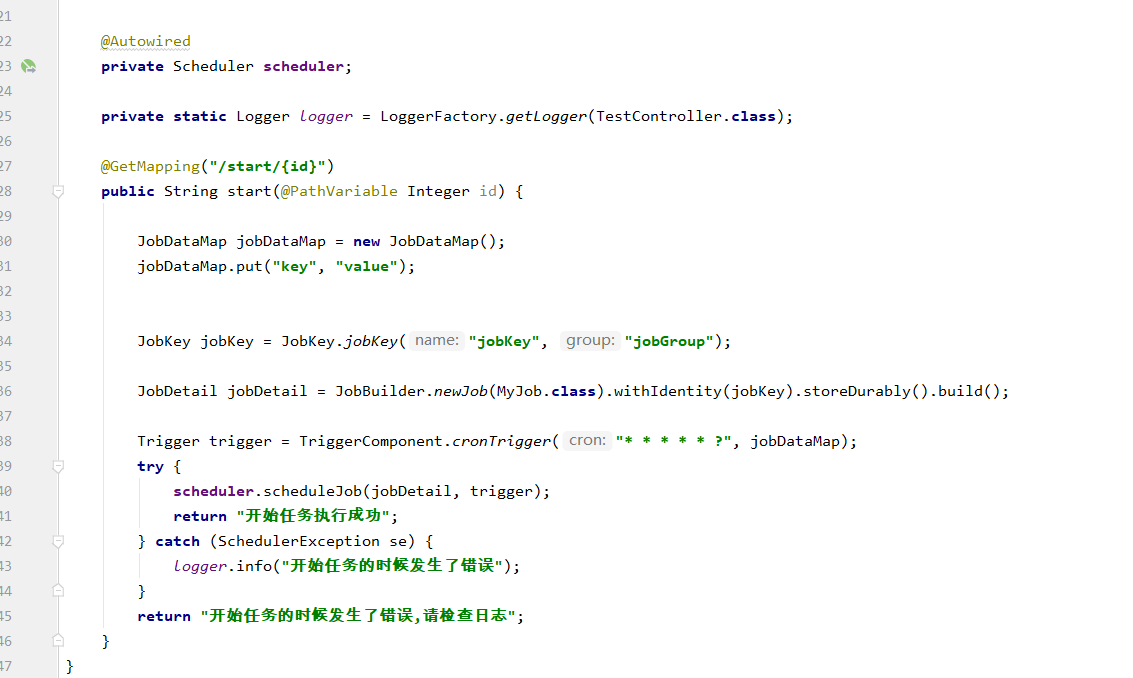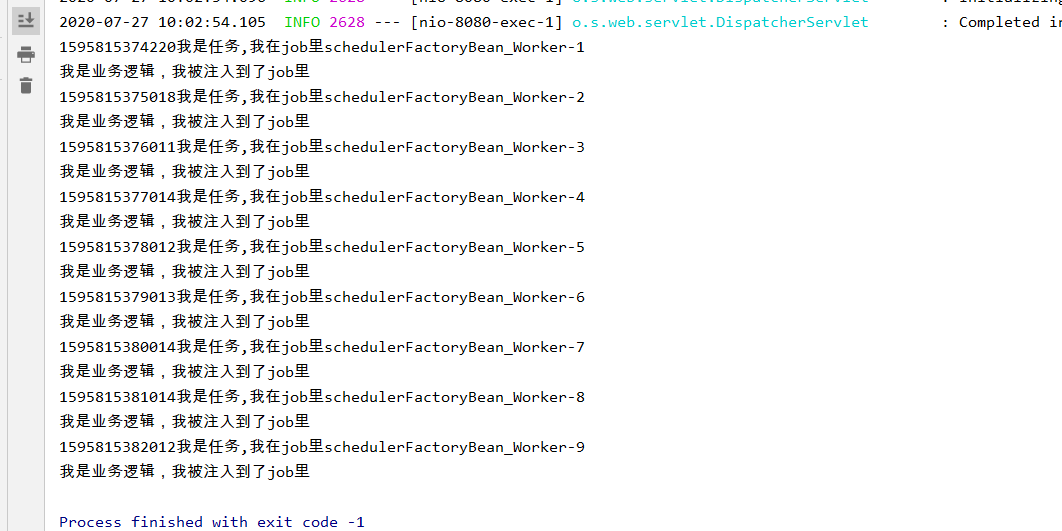springboot+quartz以持久化的方式实现定时任务
篇幅较长,耐心的人总能得到最后的答案
小生第一次用quartz做定时任务,不足之处多多谅解。
首先
在springboot项目里做定时任务是比较简单的,最简单的实现方式是使用@Scheduled注解,
然后在application启动类上使用@EnableScheduling开启定时任务。
示例
@SpringBootApplication
@EnableScheduling
public class Application {
public static void main(String[] args) {
SpringApplication.run(Application.class, args);
}
// cron为每秒执行一次
@Scheduled(cron = "* * * * * ?")
public void print(){
System.out.println("执行定时任务");
}
}
结果
执行定时任务
执行定时任务
执行定时任务
执行定时任务
执行定时任务
执行定时任务
执行定时任务
执行定时任务
简单的定时任务就可以用这种方式来做,cron表达式的结果为任务执行的间隔时间。这里放几个在线生成cron表达式的链接西施-王昭君-貂蝉-杨玉环四大美女!香不香
然而
实际开发中,我们的任务可能有很多,且需要手动操作单个/全部的任务,比如添加、开启、停止、继续等等操作。那么伴随着(千牛B类。。。)的BGM有请quartz登场。
quartz
整合
<dependency>
<groupId>org.springframework.boot</groupId>
<artifactId>spring-boot-starter-quartz</artifactId>
</dependency>
quartz的三要素
调度器Scheduler
启动触发器去执行任务
触发器Trigger
用来定义Job(任务)触发条件、触发时间,触发间隔,终止时间等
任务job
具体要执行的任务内容
使用
使用quartz是需要配置文件的,quartz.properties
在quartz的jar包的org.quartz包下可以找到默认的配置文件quartz.properties
# Default Properties file for use by StdSchedulerFactory
# to create a Quartz Scheduler Instance, if a different
# properties file is not explicitly specified.
#
# 名字
org.quartz.scheduler.instanceName: DefaultQuartzScheduler
org.quartz.scheduler.rmi.export: false
org.quartz.scheduler.rmi.proxy: false
org.quartz.scheduler.wrapJobExecutionInUserTransaction: false
# 实例化ThreadPool时,使用的线程类为SimpleThreadPool
org.quartz.threadPool.class: org.quartz.simpl.SimpleThreadPool
# 线程总个数
org.quartz.threadPool.threadCount: 10
# 线程的优先级
org.quartz.threadPool.threadPriority: 5
org.quartz.threadPool.threadsInheritContextClassLoaderOfInitializingThread: true
org.quartz.jobStore.misfireThreshold: 60000
# 持久化方式,默认持久化在内存中,后面我们使用db的方式
org.quartz.jobStore.class: org.quartz.simpl.RAMJobStore
quartz任务持久化到db则需要一些官方定义的数据库表,表的sql文件可以在quartz的jar包里找到
坐标org.quartz.impl.jdbcjobstore,可以看到里面有很多sql文件,有各种数据库的,咱们用MySQL的,咱们不需要手动执行sql语句,后面咱们在启动项目的时候自动初始化。
创建我们自己的properties文件
# 实例化ThreadPool时,使用的线程类为SimpleThreadPool
org.quartz.threadPool.class=org.quartz.simpl.SimpleThreadPool
# threadCount和threadPriority将以setter的形式注入ThreadPool实例
# 并发个数
org.quartz.threadPool.threadCount=10
# 优先级
org.quartz.threadPool.threadPriority=5
org.quartz.threadPool.threadsInheritContextClassLoaderOfInitializingThread=true
org.quartz.jobStore.misfireThreshold=5000
#持久化使用的类
org.quartz.jobStore.class=org.quartz.impl.jdbcjobstore.JobStoreTX
#数据库中表的前缀
org.quartz.jobStore.tablePrefix=QRTZ_
#数据源命名
org.quartz.jobStore.dataSource=qzDS
#qzDS 数据源,我们使用hikaricp,默认的是c3p0
org.quartz.dataSource.qzDS.provider=hikaricp
org.quartz.dataSource.qzDS.driver=com.mysql.cj.jdbc.Driver
org.quartz.dataSource.qzDS.URL=jdbc:mysql://localhost:3306/quartz?useUnicode=true&characterEncoding=UTF-8&serverTimezone=GMT%2B8
org.quartz.dataSource.qzDS.user=root
org.quartz.dataSource.qzDS.password=123456
org.quartz.dataSource.qzDS.maxConnections=10
既然我们没有使用默认的连接池,那么就探索一下,上源码!
在这个包下:org.quartz.utils,有一个PoolingConnectionProvider,顾名思义,连接池提供者
部分源码
public interface PoolingConnectionProvider extends ConnectionProvider {
/** The pooling provider. */
String POOLING_PROVIDER = "provider";
/** The c3p0 pooling provider. */
String POOLING_PROVIDER_C3P0 = "c3p0";
/** The Hikari pooling provider. */
String POOLING_PROVIDER_HIKARICP = "hikaricp";
}
然后HikariCpPoolingConnectionProvider这个类实现了PoolingConnectionProvider,自行查看。
我们可以在org.quartz.impl下的StdSchedulerFactory中搜索c3p0找到
if(poolingProvider != null && poolingProvider.equals(PoolingConnectionProvider.POOLING_PROVIDER_HIKARICP)) {
cpClass = "org.quartz.utils.HikariCpPoolingConnectionProvider";
}
else {
cpClass = "org.quartz.utils.C3p0PoolingConnectionProvider";
}
剩下的自己多看看吧,起始源码研究起来没有想象中那么难那么乏味(我也不喜欢看源码),但是这个源码看起来确实小有成就感。
回到正题频道,配置application.yml
spring:
datasource:
driver-class-name: com.mysql.cj.jdbc.Driver
password: 123456
url: jdbc:mysql://localhost:3306/quartz?characterEncoding=UTF8&useSSL=false&serverTimezone=GMT%2B8
username: root
quartz:
jdbc:
initialize-schema: always
job-store-type: jdbc
initialize-schema: always每次启动项目,总是初始化数据库表自动创建表的关键地方,流程是先删除数据库表,再创建,如果表不存在,则抛异常,但是不会影响后面的生成表,下次再启动项目的时候,由于表已经存在了,所以不会再抛异常了
job-store-type: jdbc就是任务持久化类型,我们用jdbc
我们可能要在job里注入spring对象,不做配置,是无法注入的。
/**
* @author: taoym
* @date: 2020/6/4 11:32
* @desc: 一定要自定义JobFactory重写SpringBeanJobFactory的createJobInstance方法,否则在job中是获取不到spring容器中的bean的
*/
@Component
public class JobFactory extends SpringBeanJobFactory {
@Autowired
private AutowireCapableBeanFactory beanFactory;
/**
* 这里覆盖了super的createJobInstance方法,对其创建出来的类再进行autowire
*/
@Override
protected Object createJobInstance(TriggerFiredBundle bundle) throws Exception {
Object jobInstance = super.createJobInstance(bundle);
beanFactory.autowireBean(jobInstance);
return jobInstance;
}
}
创建quartz的配置文件
@Configuration
public class QuartzConfig {
@Autowired
private JobFactory jobFactory;
/**
* 读取quartz.properties 文件
* 将值初始化
*
* @return
*/
@Bean
public Properties quartzProperties() throws IOException {
PropertiesFactoryBean propertiesFactoryBean = new PropertiesFactoryBean();
propertiesFactoryBean.setLocation(new ClassPathResource("/quartz.properties"));
propertiesFactoryBean.afterPropertiesSet();
return propertiesFactoryBean.getObject();
}
@Bean
public SchedulerFactoryBean schedulerFactoryBean() throws IOException {
SchedulerFactoryBean schedulerFactoryBean = new SchedulerFactoryBean();
schedulerFactoryBean.setJobFactory(jobFactory);
schedulerFactoryBean.setQuartzProperties(quartzProperties());
return schedulerFactoryBean;
}
/**
* 初始化监听器
*
* @return
*/
@Bean
public QuartzInitializerListener executorListener() {
return new QuartzInitializerListener();
}
@Bean(name = "scheduler")
public Scheduler scheduler() throws IOException {
return schedulerFactoryBean().getScheduler();
}
}
创建触发器组件
public class TriggerComponent {
/**
* @author: taoym
* @date: 2020/6/1 10:35
* @desc: 构建cron触发器
*/
public static Trigger cronTrigger(String cron) {
CronTrigger cronTrigger = TriggerBuilder.newTrigger()
.withSchedule(CronScheduleBuilder.cronSchedule(cron).withMisfireHandlingInstructionDoNothing())
.build();
return cronTrigger;
}
public static Trigger cronTrigger(String cron, JobDataMap jobDataMap) {
CronTrigger cronTrigger = TriggerBuilder.newTrigger()
.withSchedule(CronScheduleBuilder.cronSchedule(cron).withMisfireHandlingInstructionDoNothing())
.usingJobData(jobDataMap)
.build();
return cronTrigger;
}
}
触发器就用这个组件来获取就行了。
创建任务
@DisallowConcurrentExecution
public class TestJob extends QuartzJobBean {
@Override
protected void executeInternal(JobExecutionContext jobExecutionContext) throws JobExecutionException {
}
}
jobExecutionContext这里面可以获取任务组、任务名、触发器组、触发器名、jobdetail等信息。
那个注解是为了让同一个实例(jobdetail)只能单线程执行。
可以这么理解,job为接口,jobdetail为实现类,a是其中一个实现类,a需要花费100s执行一定的操作,而你给的定时器是没50s就执行一次操作,a在执行到一半的时候又需要开启一个线程来执行。使用了DisallowConcurrentExecution就相当于a没有把操作执行完的时候,a不允许开启线程再执行当前操作。
不知道我的描述是否易懂!
按需创建自己的任务表,我是用定时任务做爬虫的(小爬虫)
CREATE TABLE `quartz_job` (
`id` int(11) NOT NULL AUTO_INCREMENT COMMENT '编号',
`job_name` varchar(50) DEFAULT '' COMMENT '任务名',
`job_group` varchar(50) DEFAULT '' COMMENT '任务组名称',
`job_desc` varchar(255) DEFAULT '' COMMENT 'job描述',
`cron` varchar(50) DEFAULT '' COMMENT 'cron表达式',
`status` tinyint(1) DEFAULT '0' COMMENT '状态',
`url` varchar(255) DEFAULT '' COMMENT '请求地址',
`param` varchar(255) DEFAULT '' COMMENT '参数',
PRIMARY KEY (`id`)
) ENGINE=InnoDB AUTO_INCREMENT=31 DEFAULT CHARSET=utf8;
我们添加任务的时候不和quartz打交道,把任务放到数据库即可。别慌,后面有用到他的地方。
这个表需要有增删改查操作,我们会在系统中查询任务列表选择单个或者所有任务开始执行
执行任务
@Resource
private QuartzJobMapper quartzJobMapper;
@Autowired
private Scheduler scheduler;
@Override
public String start(Integer id) {
JobDataMap jobDataMap = new JobDataMap();
jobDataMap.put(k,v);
QuartzJob quartzJob = quartzJobMapper.selectByPrimaryKey(id);
JobKey jobKey = JobKey.jobKey(quartzJob.getJobName(), quartzJob.getJobGroup());
jobDetail = JobBuilder.newJob(TestJob.class).withIdentity(jobKey).storeDurably().build();
Trigger trigger = TriggerComponent.cronTrigger(quartzJob.getCron(), jobDataMap);
try {
scheduler.scheduleJob(jobDetail, trigger);
quartzJobMapper.updateStatus(true, id);
return "开始任务执行成功";
} catch (SchedulerException se) {
log.info("开始任务的时候发生了错误");
}
return "开始任务的时候发生了错误,请检查日志";
}
最后我又按照此教程上的内容粘贴了一遍代码,可以正常运行。





转载请说明来源,谢谢!